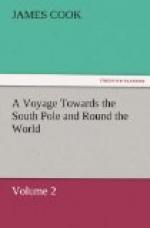The annexed chart will very accurately shew the direction, extent, and position of the coast, along which I have sailed, either in this or my former voyage. The latitudes have been determined by the sun’s meridian altitude, which we were so fortunate as to obtain every day, except the one we sailed from Christmas Sound, which was of no consequence, as its latitude was known before. The longitudes have been settled by lunar observations, as is already mentioned. I have taken 67 deg. 46’ for the longitude of Cape Horn. From this meridian the longitudes of all the other parts are deduced by the watch, by which the extent of the whole mast be determined to a few miles; and whatever errors there may be in longitude, must be general. But I think it highly probable that the longitude is determined to within a quarter of a degree. Thus the extent of Terra del Fuego from east to west, and consequently that of the straits of Magalhaens, will be found less than most navigators have made it.
In order to illustrate this and to shew the situations of the neighbouring lands, and, by this means, make the chart of more general use, I have extended it down to 47 deg. of latitude. But I am only answerable for the accuracy of such parts as I have explored myself. In laying down the rest I had recourse to the following authorities.
The longitude of Cape Virgin Mary, which is the most essential point, as it determines the length of the straits of Magalhaens, is deduced from Lord Anson, who made 2 deg. 30’ difference of longitude between it and the Strait Le Maire. Now as the latter lies in 65 deg. 22’, Cape Virgin-Mary must lie in: 67 deg. 52’, which is the longitude I have assigned to it, and which, I have reason to think, cannot be far from the truth.
The strait of Magalhaens, and the east coast of Patagonia, are laid down from the observations made by the late English and French navigators.
The position of the west coast of America, from Cape Victory northward, I have taken from the discoveries of Sarmiento, a Spanish navigator, communicated to me by Mr Stuart, F.R.S.
Falkland Islands are copied from a sketch taken from Captain M’Bride, who circumnavigated them some years ago in his majesty’s ship Jason; and their distance from the main is agreeable to the run of the Dolphin, under the command of Commodore Byron, from Cape Virgin Mary to Port Egmont, and from Port Egmont to Port Desire, both of which runs were made in a few days; consequently no material errors could happen.
The S.W. coast of Terra del Fuego, with respect to inlets, islands, etc. may be compared to the coast of Norway; for I doubt if there be an extent of three leagues where there is not an inlet or harbour which will receive and shelter the largest shipping. The worst is, that till these inlets are better known, one has, as it were, to fish for anchorage. There are several lurking rocks on the coast, but happily none of them lie far from land, the approach to which may be known by sounding, supposing the weather so obscure that you cannot see it. For to judge of the whole by the parts we have sounded, it is more than probable that there are soundings all along the coast, and for several leagues out to sea. Upon the whole, this is by no means the dangerous coast it has been represented.




